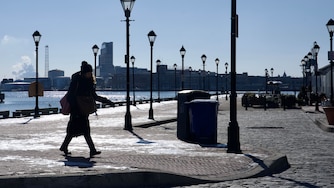How do you get drivers to slow down on a straight road? One option is to make it curvier.
It’s called a chicane. Instead of staying straight, the road’s lanes periodically shift to the left or right, then back — a shoulder may disappear halfway down a block and then reappear at the next block as the lane markers guide drivers back toward the middle of the road.
The theory behind chicanes is simple: If drivers must pay more attention to stay in their lane, they are less likely to speed or drive distracted. It’s part of the same toolkit as things like speed humps that traffic planners turn to when there are safety concerns on a specific roadway. They’ve worked in Europe and in Seattle, but some people complain they don’t work and result in lost parking. Now, Baltimore is trying them out for the first time.

Baltimore’s transportation department plans to tear out about 10 speed humps along Glenmore Avenue in Northeast Baltimore and install chicanes instead. If it goes well, it could mean other roads around Baltimore could get curvier.
Installing speed humps in their neighborhood is one of the most popular requests of city residents, officials have said, but they are often left waiting years to get them. Chicanes could offer a quicker, easier alternative.
“I’m just really happy to see this design,” said Ryan Dorsey, the city councilman for the 3rd District, at a community meeting held last week by transportation officials to review the road changes with neighbors. “I think it’s really important to try new things.”
Dorsey, a vocal and sometimes prickly advocate for active transportation and traffic calming, represents a district with multiple busy commuting corridors that have seen a high number of traffic crashes. Glenmore Avenue connects two of them: Harford and Belair roads, with another, Walther Avenue, in between. A pedestrian was struck and killed this past weekend on Belair Road, just around the corner from Glenmore, according to Baltimore Police, and another was killed 3½ miles southwest a couple of nights before that.
A driver struck and killed a 43-year-old man walking in the 6600 block of Belair Road last night. https://t.co/rZ85CRAh0V
— Ryan Dorsey (@ElectRyanDorsey) November 23, 2024
When the city installed speed humps on Glenmore years ago, it drastically reduced unsafe speeding along the road, according to a couple of residents who live along the road present at the meeting. But the humps created other bumps — for example, they pose mobility problems for residents who use wheelchairs.
The mobility issue made this a “high-priority area,” said Qiana Gabriel from the Baltimore City Department of Transportation’s traffic division. And their counterparts in the Americans with Disabilities Act office signed off on the design for the chicanes, which is about 90% complete, officials said.
But a couple of virtual attendees argued the mobility issue is fundamentally a sidewalk problem, not a roadway one.
The sidewalks on Glenmore are unnavigable for wheelchair users, said one person who identified himself as Taylor M. It’s forced people in wheelchairs into the roadway, where they have to traverse the speed humps, he explained. Installing chicanes in the road doesn’t change that, so some residents worry transportation officials are just replacing one unsafe design with another.
The scale of the city’s sidewalk problem is much bigger than just Glenmore Avenue — it’s massive. In 2021, the transportation department estimated that roughly 66% of city sidewalks and 98% of curb ramps and medians weren’t compliant with the ADA. Fixing those issues would cost more than $650 million, officials said.
The city even got sued over it in 2021. Earlier this month, Baltimore reached a $44 million settlement in the lawsuit filed by Disability Rights Maryland. The payout pales in comparison with the scale of the need, but city officials called it just a first step.
It will be a while before Glenmore gets new sidewalks — it would be a whole new capital spending project. Gabriel said the traffic division is working with the ADA office toward a permanent solution.
When the chicanes go in, wheelchair users could use the shoulder, but then would need to cross the street each time the lanes shift and the shoulder goes away. And that doesn’t account for when cars park in the shoulder, effectively blocking it. The chicanes will use plastic flexposts to mark the lane shifts, not concrete curbs or other options that can physically slow an errant car, like speed humps.
Some are willing to see whether chicanes can slow traffic like the speed humps, though.
“Those speed humps drive me crazy,” said Melanie Willner, who lives on Glenmore.
Though she appreciates how successful they’ve been in calming traffic, she said speed humps, intersection bump-outs and other “complete streets” changes to roadways pose too many challenges for buses and emergency vehicles. But if the chicanes work, she’ll support them.
Richard Wilke, another neighbor, is willing to try them out, too. He said that living right next to one of the speed humps has been a hassle. And though the chicanes might not make everyone happy, if they slow drivers down on his street, he’ll see it as a success.
“I think that doing nothing is the wrong thing to do,” Wilke said.
The switch from bumps to chicanes should be complete by the end of the year, according to a spokesperson for the city transportation department. The second set of design plans are currently being reviewed based on community feedback, she added.
The spokesperson declined to give an exact figure regarding how much the switch would cost but said that DOT’s own team, not a contractor, would remove the speed humps, and called chicanes a “low cost solution.”
A formal comment period for the proposed changes is now open through Dec. 2. The public can submit their feedback via email to dot.engagement@baltimorecity.gov.





Comments
Welcome to The Banner's subscriber-only commenting community. Please review our community guidelines.